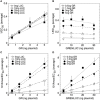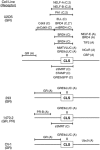An Approach to Greater Specificity for Glucocorticoids
- PMID: 29593646
- PMCID: PMC5859375
- DOI: 10.3389/fendo.2018.00076
An Approach to Greater Specificity for Glucocorticoids
Abstract
Glucocorticoid steroids are among the most prescribed drugs each year. Nonetheless, the many undesirable side effects, and lack of selectivity, restrict their greater usage. Research to increase glucocorticoid specificity has spanned many years. These efforts have been hampered by the ability of glucocorticoids to both induce and repress gene transcription and also by the lack of success in defining any predictable properties that control glucocorticoid specificity. Correlations of transcriptional specificity have been observed with changes in steroid structure, receptor and chromatin conformation, DNA sequence for receptor binding, and associated cofactors. However, none of these studies have progressed to the point of being able to offer guidance for increased specificity. We summarize here a mathematical theory that allows a novel and quantifiable approach to increase selectivity. The theory applies to all three major actions of glucocorticoid receptors: induction by agonists, induction by antagonists, and repression by agonists. Simple graphical analysis of competition assays involving any two factors (steroid, chemical, peptide, protein, DNA, etc.) yields information (1) about the kinetically described mechanism of action for each factor at that step where the factor acts in the overall reaction sequence and (2) about the relative position of that step where each factor acts. These two pieces of information uniquely provide direction for increasing the specificity of glucocorticoid action. Consideration of all three modes of action indicate that the most promising approach for increased specificity is to vary the concentrations of those cofactors/pharmaceuticals that act closest to the observed end point. The potential for selectivity is even greater when varying cofactors/pharmaceuticals in conjunction with a select class of antagonists.
Keywords: antiglucocorticoids; glucocorticoid specificity; induction; kinetic mechanism of cofactor action; mathematical model; repression; selective glucocorticoid receptor modulators; site of cofactor action.
Figures





References
Publication types
LinkOut - more resources
Full Text Sources
Other Literature Sources

